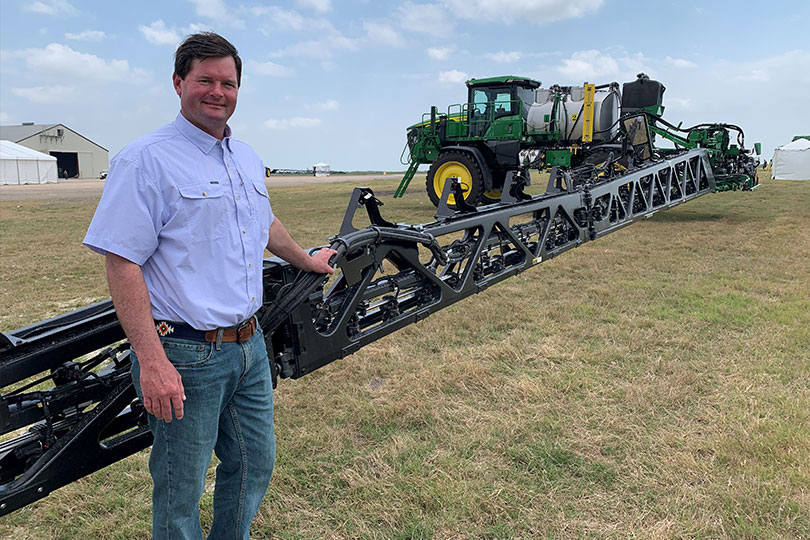By Carey Martin
TFB Radio Network Manager
Sustainability is a big buzzword in agriculture, and new sprayer technology unveiled by John Deere will make Texas farms even more environmentally friendly. It is called “See and Spray,” and that is an accurate description of what it does.
Using cameras and computer processors, the sprayer can tell the difference between the crop and the weeds, then tell the spray nozzle to spot spray only the weeds.
“It has 36 cameras across the top of the boom. Think of those as the eyes of the system,” said Kathleen Sprouse, senior product manager for Blue River Technology, a subsidiary company of John Deere. “Then there are 11 processors along the boom that decide if there’s a weed or the crop based on the images. If it sees a weed, the system actuates the exact supply nozzle to just cover that weed.”
This entire process takes a mere 0.2 seconds while the sprayer is travelling up to 12 miles per hour.
The See and Spray technology has been tested in Texas for over a year.
“We’ve been down here for more than a year in different parts of South Texas working with the King Ranch and having phenomenal performance,” said Franklin Peitz, tactical marketing manager for John Deere sprayers.
One of the biggest benefits of the See and Spray technology is the reduction in herbicide use when spot spraying versus spraying the herbicide on the entire field.
“We’re seeing up to two thirds savings on non-residual herbicides,” Sprouse said. “This technology brings farmers an incredible opportunity to reduce their spending on herbicide.”
Farmers are known to be skeptical of big claims like that, but John Deere has made a believer of at least one Texas farmer.
Sam Sparks farms more than 10,000 acres in the Rio Grande Valley and has been testing the See and Spray technology for over a year.
“To be honest with you, I didn’t really believe at first that these cameras and the technology were going to be able to communicate with the sprayer in a precise manner,” Sparks said. “But I was just blown away at the results we were seeing. Being able to operate at 9, 10, 12 miles per hour and the machine is able to pick up on these weeds, spray them and move down the road.”
Sparks noted the benefits are immense, in addition to the obvious savings on chemical costs.
“You’re saving on diesel, labor and wear and tear on equipment. You’re not stopping as often to fill up the sprayer,” he said. “It all adds up to what I believe is a lot of money.”
Another benefit of the new sprayer is the ability to combine two chemical treatments into one. The tank is split into two separate tanks, and there is a second set of nozzles along the back of the boom, which would allow for a spot treatment with the front set of nozzles and a broadcast spray of the entire field with the back set.
“If they want to spray a fungicide, insecticide or residual herbicide broadcast, then spot spray a non-residual, they could do that all in one pass, which could only have previously been done in two passes,” Peitz said.
For now, See and Spray can only be used in cotton, corn and soybeans with 30-inch rows or greater.
John Deere is planning a limited roll out of See and Spray sprayers in select states, including Texas.
“We will have our initial ordering this fall in Texas, Mississippi, Tennessee, Illinois, Iowa and Nebraska,” Peitz said. “Next year, it will be available across the United States.”

